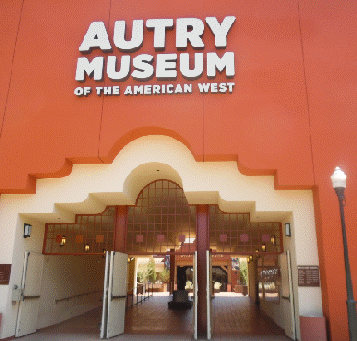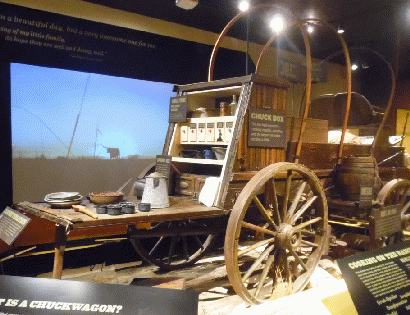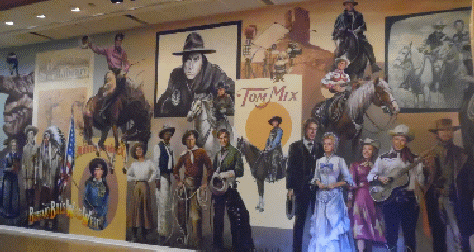

Either in fact or legend the American West has been a fascination for not only Americans but people from almost every part of the world. From early dime novels, then cinema and radio and finally television the myths of the West have continued to entertain.
All of this, both the fact and the fiction, is on display at Autry's Museum of the American West.
We visited the Museum recently to see the special exhibition of photographs taken after the earthquake and fire that destroyed much of San Francisco in April 1906.
This Writer was born and reared in San Francisco and since my Grandparents, Mother and Aunts had survived the quake there were many stories to be told of the event by family and friends.
My Mother was six years old when the family had to climb aboard my Grandfather's horse drawn wagon and flee their home for the safety of Golden Gate Park, and never to return, So this then is my Family's history of that eventful day.
For my Grandparents Wednesday, April 18th, 1906 would have started like any other work day. My Grandfather was in the produce business which meant that his day started in the very early hours of each day, a practice that continues in that business to the present.
My Grandmother's day also started at that early hour since she always prepared a hearty breakfast for her husband. Still asleep would be their three daughters, Antoinette, Josephine, and Mary. Later they would be up and made ready to attend a grammar school in the area.
Meanwhile my grandfather, Salvatore would have hitched up his horse and wagon and be on his way to the produce market located at the foot of Sacramento Street and from where he lived it was not a great distance.
They lived in North Beach, an Italian district in San Francisco, and as immigrants were just starting on a road that would lead to economic security and the American dream, for them later in life, their children and future generations as well.
At 5:12 that morning the world changed for them and almost every other person residing in San Francisco. An earthquake struck which shook the brick and wood built city to its foundations. Trained observers later said the shaking lasted a full two and one half minutes. When it stopped a magnificent city lay in ruins and the fires began.
My Grandfather was going down Market Street toward the waterfront when the earthquake struck. He actually saw the City Hall dome collapse, which in those days was located near Second and Market Street.
My Grandfather immediately turned around the horse and wagon and returned home to North Beach with fires already to be seen. He gathered up his wife, who was five months pregnant and his three daughters. With the fires increasing very rapidly all they saved was one trunk, leaving everything else behind including furniture, clothing and personal items.
Like thousands of other San Franciscans Golden Gate Park was their refuge and home, an Army tent, for the next several months and while there my Grandmother gave birth to their first son in August 1906.
Among the exhibition photos is one showing rows of tents in Golden Gate Park.
A book by Simon Winchester entitled "The Crack at the Edge of the World" is a well told story of both the San Francisco 1906 earthquake and why the San Andreas Fault acts as it sometimes does.

Allow plenty of time for a visit to this Museum. Both the cinema myths of the West as well as the real life of the cowboy and frontiersman are shown. We spent a long time viewing the wonderful collection of paintings which show the West as viewed by 19th Century artists.
A current exhibition presents more than one hundred native art paintings, sculptures, drawings, and prints by contemporary artist Rick Bartow.
There are also two Community Galleries one depicted how the Mormon pioneers centered in small communities as they developed farms and ranches rather than scattered over the countryside. The second shows how the Navajo continue to pursue their unique and traditional way of life.
Yes there is the chronicle of the rise of the "singing cowboys" but also how the real cowboy lived and the tools of his trade which seldom included a "six-shooter" but often the "chuck wagon" which is included in the exhibit.
There is a very complete collection of the firearms that were used in the 18th and 19th century as the west was settled. While another exhibit describes the early days of 'law and order' as western communities came into being.
We spent some time admiring the full scale classic western Saloon complete with a beautifully carved one hundred year old back bar as well as nearby tools for gambling and 'bucking the tiger'. Also the gallery of the real 'western badmen' and a few of the 'good guys' as well.

The Museum also includes the Autry Store and the Crossroads West Cafe. Both have the same hours as the museum. The Autry Museum of the American West is located at 4700 Western Heritage Way in Griffith Park across from the Los Angeles Zoo. There is free parking. The Museum is open Tuesday to Sunday from 10 a.m. to 4 p.m. For more information check the web at www.theautry.org.

Graphic Design by Impact Graphics